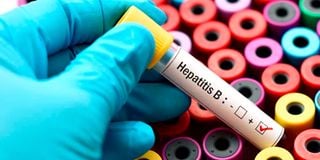What you should know about viral hepatitis

Hepatitis B and C are responsible for 95 percent of Hepatitis-related sicknesses.
What you need to know:
- Hepatitis is an inflammation of the liver, a vital organ that processes nutrients, filters the blood and fights infections. When the liver is inflamed or damaged, its functions can be compromised.
- Hepatitis is most commonly caused by a viral infection, but toxins, certain drugs, heavy alcohol use and bacterial infections can also cause the condition.
By Dr Christopher Opio
Chronic hepatitis B can develop into a serious disease resulting in long-term health problems, including liver damage, liver failure, liver cancer, and even death.Dr Christopher Opio, consultant gastroenterologist at Aga Khan University Hospital, discusses things you should know about viral hepatitis.
Hepatitis is an inflammation of the liver, a vital organ that processes nutrients, filters the blood and fights infections. When the liver is inflamed or damaged, its functions can be compromised. Hepatitis is most commonly caused by a viral infection, but toxins, certain drugs, heavy alcohol use and bacterial infections can also cause the condition.
Every 30 seconds, someone dies from a viral hepatitis related illness. More than 350 million people live with viral hepatitis and nine in 10 people are unaware of their diagnosis.
Viral hepatitis can be fatal
There are five main hepatitis viruses referred to as types A, B, C, D and E.People who contract hepatitis A and E mostly recover with supportive care.
In the case of the B, C, and D viruses, the infection can become chronic and some patients may die of liver cancer or cirrhosis, but if the infection is detected in time, it can be treated. Patients with the hepatitis C virus can recover completely.
There are vaccines that protect against viral hepatitis A, B, D and E.
Hepatitis A and E are transmitted through unsafe water, contaminated food and poor sanitation.
Hepatitis B and D are mainly transmitted via sexual and bloodborne contacts
Hepatitis C is transmitted via blood transfusions and injections
The hepatitis B virus is 10 times more infectious than HIV because of high viral levels in blood.
A pregnant woman who has hepatitis B can transmit the virus to her child during birth. Administering the hepatitis B vaccine to newborns during the first 24 hours after birth is the most effective measure for protecting babies.
Do not share syringes or razors
Hepatitis B, C and D can be transmitted through an infected person's body fluids. People who inject drugs have a high risk of infection since they sometimes share syringes. In order to avoid the risk of infection, do not share razors, syringes, or unsterilised instruments used for tattooing or piercing.
Everybody needs to be screened for hepatitis B and C
Before the 1990s, blood for transfusion was not screened to detect viral hepatitis. It is recommended that all people over the age of 40 be given a blood test to determine if they are carriers of the virus.
People who have received a blood transfusion in a country that does not screen for viral hepatitis should also be tested.
Hepatitis C can lead to cirrhosis without apparent symptoms
The hepatitis C virus can remain in a person's blood for up to 20 years without apparent symptoms, until it causes inflammation and damage to the liver, which can develop into chronic hepatitis, cirrhosis or liver cancer. The good news is that Hepatitis C can be cured.
What worsens liver damage due to viral hepatitis
Alcohol use, non-alcoholic fatty liver disease, certain medications, herbal remedies, aflatoxins and certain infections increase one’s risk of liver cancer.
A healthy diet is recommended for adults
Breakfast, lunch and supper should comprise 50 per cent of vegetables and fruits, 25 per cent animal and plant proteins, 24 per cent carbohydrates, and less than one per cent healthy fats. Drink enough water/ fluids – 2.5 – three litres per day.




